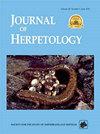There's No Place Like Home: Influential Habitat Characteristics of Eastern Tiger Salamander (Ambystoma tigrinum tigrinum) Breeding Ponds in Maryland and Delaware
IF 0.8
4区 生物学
Q3 ZOOLOGY
引用次数: 0
Abstract
Abstract. Habitat loss, degradation, and modification are important drivers of global population declines in amphibians. Most amphibians have a biphasic lifestyle and are susceptible to threats in both aquatic and terrestrial habitats. Eastern Tiger Salamanders (Ambystoma tigrinum tigrinum) are endangered throughout much of their range in the eastern United States, including Maryland and Delaware. Ambystoma t. tigrinum breed in ephemeral freshwater ponds and then migrate into the surrounding terrestrial environment after metamorphosis. Limited research exists about what habitat characteristics play a role in breeding pond use. We sought to understand what features of the breeding pond and surrounding landscape influence abundance and occupancy. We measured salamander occupancy, salamander abundance, and water quality parameters at ponds during the 2018 and 2019 breeding seasons. We used geographic information systems to determine pond area and the percentage of forest area and road density surrounding a pond at four spatial scales. Pond occupancy by A. t. tigrinum was positively associated with increased depth and less forest cover at the largest spatial scales. Abundance of A. t. tigrinum was greatest in larger, deeper ponds, potentially because these factors increase hydroperiod. More basic pH and decreased conductivity were also associated with higher male salamander abundances in ponds. Forest area and road density were not in the top-ranked model, although we note that ponds in this study had a minimum of 70% forest area within 150 m. Our findings elucidate relationships between A. t. tigrinum and their habitat, providing knowledge for future management of this state-endangered species.没有比家更好的地方:马里兰州和特拉华州东部虎蝾螈(Ambystoma tigrinum tigrinum)繁殖池的栖息地特征
本文章由计算机程序翻译,如有差异,请以英文原文为准。
求助全文
约1分钟内获得全文
求助全文
来源期刊

Journal of Herpetology
生物-动物学
CiteScore
1.60
自引率
0.00%
发文量
45
审稿时长
6 months
期刊介绍:
The Journal of Herpetology accepts manuscripts on all aspects on the biology of amphibians and reptiles including their behavior, conservation, ecology, morphology, physiology, and systematics, as well as herpetological education. We encourage authors to submit manuscripts that are data-driven and rigorous tests of hypotheses, or provide thorough descriptions of novel taxa (living or fossil). Topics may address theoretical issues in a thoughtful, quantitative way. Reviews and policy papers that provide new insight on the herpetological sciences are also welcome, but they must be more than simple literature reviews. These papers must have a central focus that propose a new argument for understanding a concept or a new approach for answering a question or solving a problem. Focus sections that combine papers on related topics are normally determined by the Editors. Publication in the Long-Term Perspectives section is by invitation only. Papers on captive breeding, new techniques or sampling methods, anecdotal or isolated natural history observations, geographic range extensions, and essays should be submitted to our sister journal, Herpetological Review.
 求助内容:
求助内容: 应助结果提醒方式:
应助结果提醒方式:


